Effects of Orography on the High-Temperature Event on 22 June 2023 in North China
Abstract
1. Introduction
2. Data and Experimental Design
3. Case Overview and Large-Scale Circulation
4. Results
4.1. Simulated 2 m Air Temperature in North China
4.2. Influences of Orography on the 2 m Air Temperature
4.3. Mechanisms
4.3.1. Afternoon of 22 June 2023
4.3.2. Early Morning of 23 June 2023
5. Discussion
6. Conclusions
- (1)
- The presence of the mountains can help enhance the temperature by up to 3 °C and, thus, promote the occurrence of the high-temperature event.
- (2)
- During the daytime, the temperature enhancement at the foothill is primarily attributed to the adiabatic warming of mountain-plain circulation, which is induced by orographic thermal effects. The dynamically induced downslope is, however, suppressed during this time.
- (3)
- By contrast, the orographic dynamical effect (i.e., foehn effect) is found to play a more important role in enhancing the near-surface temperature at the foothill in the night and early morning, while the thermal effect (i.e., sensible heat flux) becomes less effective.
- (4)
- The orographic thermal effect is found to noticeably enhance the near-surface temperature to the far east of the Taihang Mountains in the night. It is due to the adiabatic warming of subsidence on the eastern and southeastern flank of the synoptic-scale anomalous anti-cyclonic circulation in the mid-lower troposphere, which is induced by orographic sensible heat flux during daytime and persists well into the night.
Author Contributions
Funding
Institutional Review Board Statement
Informed Consent Statement
Data Availability Statement
Acknowledgments
Conflicts of Interest
References
- Wang, P.; Hui, P.; Xue, D.; Tang, J. Future Projection of Heat Waves over China under Global Warming within the CORDEX-EA-II Project. Clim. Dyn. 2019, 53, 957–973. [Google Scholar] [CrossRef]
- Wang, J.; Yan, Z. Rapid Rises in the Magnitude and Risk of Extreme Regional Heat Wave Events in China. Weather Clim. Extrem. 2021, 34, 100379. [Google Scholar] [CrossRef]
- Intergovernmental Panel on Climate Change (IPCC). Climate Change 2021—The Physical Science Basis: Working Group I Contribution to the Sixth Assessment Report of the Intergovernmental Panel on Climate Change; Cambridge University Press: Cambridge, UK, 2023; pp. 1513–1766. [Google Scholar] [CrossRef]
- Wang, P.; Yang, Y.; Tang, J.; Leung, L.R.; Liao, H. Intensified Humid Heat Events Under Global Warming. Geophys. Res. Lett. 2021, 48, e2020GL091462. [Google Scholar] [CrossRef]
- Acaroğlu, H.; Güllü, M. Climate Change Caused by Renewable and Non-Renewable Energy Consumption and Economic Growth: A Time Series ARDL Analysis for Turkey. Renew. Energy 2022, 193, 434–447. [Google Scholar] [CrossRef]
- Horton, R.M.; Mankin, J.S.; Lesk, C.; Coffel, E.; Raymond, C. A Review of Recent Advances in Research on Extreme Heat Events. Curr. Clim. Change Rep. 2016, 2, 242–259. [Google Scholar] [CrossRef]
- Black, E.; Blackburn, M.; Harrison, G.; Hoskins, B.; Methven, J. Factors Contributing to the Summer 2003 European Heatwave. Weather 2004, 59, 217–223. [Google Scholar] [CrossRef]
- García-Herrera, R.; Díaz, J.; Trigo, R.M.; Luterbacher, J.; Fischer, E.M. A Review of the European Summer Heat Wave of 2003. Crit. Rev. Environ. Sci. Technol. 2010, 40, 267–306. [Google Scholar] [CrossRef]
- Coumou, D.; Rahmstorf, S. A Decade of Weather Extremes. Nat. Clim. Change 2012, 2, 491–496. [Google Scholar] [CrossRef]
- Miralles, D.G.; Teuling, A.J.; van Heerwaarden, C.C.; Vilà-Guerau de Arellano, J. Mega-Heatwave Temperatures Due to Combined Soil Desiccation and Atmospheric Heat Accumulation. Nat. Geosci. 2014, 7, 345–349. [Google Scholar] [CrossRef]
- Neal, E.; Huang, C.S.Y.; Nakamura, N. The 2021 Pacific Northwest Heat Wave and Associated Blocking: Meteorology and the Role of an Upstream Cyclone as a Diabatic Source of Wave Activity. Geophys. Res. Lett. 2022, 49, e2021GL097699. [Google Scholar] [CrossRef]
- Hua, W.; Dai, A.; Qin, M.; Hu, Y.; Cui, Y. How Unexpected Was the 2022 Summertime Heat Extremes in the Middle Reaches of the Yangtze River? Geophys. Res. Lett. 2023, 50, e2023GL104269. [Google Scholar] [CrossRef]
- Lee, Y.-Y.; Grotjahn, R. California Central Valley Summer Heat Waves Form Two Ways. J. Clim. 2016, 29, 1201–1217. [Google Scholar] [CrossRef]
- Zschenderlein, P.; Fink, A.H.; Pfahl, S.; Wernli, H. Processes Determining Heat Waves across Different European Climates. Q. J. R. Meteorol. Soc. 2019, 145, 2973–2989. [Google Scholar] [CrossRef]
- Whan, K.; Zscheischler, J.; Orth, R.; Shongwe, M.; Rahimi, M.; Asare, E.O.; Seneviratne, S.I. Impact of Soil Moisture on Extreme Maximum Temperatures in Europe. Weather Clim. Extrem. 2015, 9, 57–67. [Google Scholar] [CrossRef]
- Teng, H.; Branstator, G.; Meehl, G.A.; Washington, W.M. Projected Intensification of Subseasonal Temperature Variability and Heat Waves in the Great Plains. Geophys. Res. Lett. 2016, 43, 2165–2173. [Google Scholar] [CrossRef]
- Loikith, P.C.; Broccoli, A.J. Characteristics of Observed Atmospheric Circulation Patterns Associated with Temperature Extremes over North America. J. Clim. 2012, 25, 7266–7281. [Google Scholar] [CrossRef]
- Loikith, P.C.; Broccoli, A.J. Comparison between Observed and Model-Simulated Atmospheric Circulation Patterns Associated with Extreme Temperature Days over North America Using CMIP5 Historical Simulations. J. Clim. 2015, 28, 2063–2079. [Google Scholar] [CrossRef]
- Takane, Y.; Ohashi, Y.; Kusaka, H.; Shigeta, Y.; Kikegawa, Y. Effects of Synoptic-Scale Wind under the Typical Summer Pressure Pattern on the Mesoscale High-Temperature Events in the Osaka and Kyoto Urban Areas by the WRF Model. J. Appl. Meteorol. Climatol. 2013, 52, 1764–1778. [Google Scholar] [CrossRef]
- Yoon, D.; Cha, D.-H.; Lee, G.; Park, C.; Lee, M.-I.; Min, K.-H. Impacts of Synoptic and Local Factors on Heat Wave Events Over Southeastern Region of Korea in 2015. J. Geophys. Res. Atmos. 2018, 123, 12081–12096. [Google Scholar] [CrossRef]
- Wang, F.; Wang, Y. Potential Role of Local Contributions to Record-Breaking High-Temperature Event in Xiamen, China. Weather Clim. Extrem. 2021, 33, 100338. [Google Scholar] [CrossRef]
- Grotjahn, R. Identifying Extreme Hottest Days from Large Scale Upper Air Data: A Pilot Scheme to Find California Central Valley Summertime Maximum Surface Temperatures. Clim. Dyn. 2011, 37, 587–604. [Google Scholar] [CrossRef]
- Loikith, P.C.; Kalashnikov, D.A. Meteorological Analysis of the Pacific Northwest June 2021 Heatwave. Mon. Weather Rev. 2023, 151, 1303–1319. [Google Scholar] [CrossRef]
- Markowski, P.; Richardson, Y. Thermally Forced Winds in Mountainous Terrain. In Mesoscale Meteorology in Midlatitudes; John Wiley and Sons: Hoboken, NJ, USA, 2010; pp. 317–325. [Google Scholar] [CrossRef]
- Hersbach, H.; Bell, B.; Berrisford, P.; Hirahara, S.; Horányi, A.; Muñoz-Sabater, J.; Nicolas, J.; Peubey, C.; Radu, R.; Schepers, D.; et al. The ERA5 Global Reanalysis. Q.J.R. Meteorol. Soc. 2020, 146, 1999–2049. [Google Scholar] [CrossRef]
- Skamarock, C.; Klemp, B.; Dudhia, J.; Gill, O.; Liu, Z.; Berner, J.; Wang, W.; Powers, G.; Duda, G.; Barker, D.; et al. A Description of the Advanced Research WRF Model Version 4.3; No. NCAR/TN-556+STR; NSF: Alexandria, VI, USA, 2021. [Google Scholar] [CrossRef]
- Thompson, G.; Field, P.R.; Rasmussen, R.M.; Hall, W.D. Explicit Forecasts of Winter Precipitation Using an Improved Bulk Microphysics Scheme. Part II: Implementation of a New Snow Parameterization. Mon. Weather Rev. 2008, 136, 5095–5115. [Google Scholar] [CrossRef]
- Iacono, M.J.; Delamere, J.S.; Mlawer, E.J.; Shephard, M.W.; Clough, S.A.; Collins, W.D. Radiative Forcing by Long-Lived Greenhouse Gases: Calculations with the AER Radiative Transfer Models. J. Geophys. Res. Atmos. 2008, 113, D13. [Google Scholar] [CrossRef]
- Hong, S.-Y.; Noh, Y.; Dudhia, J. A New Vertical Diffusion Package with an Explicit Treatment of Entrainment Processes. Mon. Weather. Rev. 2006, 134, 2318–2341. [Google Scholar] [CrossRef]
- Tewari, M.; Chen, F.; Wang, W.; Dudhia, J.; Lemone, M.A.; Mitchell, K.; Ek, M.; Gayno, G.; Wegiel, J.; Cuenca, R.H. Implementation and verification of the unified NOAH land surface model in the WRF model. In Proceedings of the 20th Conference on Weather Analysis and Forecasting/16th Conference on Numerical Weather Prediction, Seattle, WA, USA, 14 January 2004; pp. 11–15. Available online: http://n2t.net/ark:/85065/d7fb523p (accessed on 1 September 2023).
- Jiménez, P.A.; Dudhia, J.; González-Rouco, J.F.; Navarro, J.; Montávez, J.P.; García-Bustamante, E. A Revised Scheme for the WRF Surface Layer Formulation. Mon. Weather Rev. 2012, 140, 898–918. [Google Scholar] [CrossRef]
- Smith, R.B. On Severe Downslope Winds. J. Atmos. Sci. 1985, 42, 2597–2603. [Google Scholar] [CrossRef]
- Holton, J.R.; Hakim, G.J. Chapter 6—Quasi-Geostrophic Analysis. In An Introduction to Dynamic Meteorology, 5th ed.; Holton, J.R., Hakim, G.J., Eds.; Academic Press: New York, NY, USA, 2013; pp. 171–211. [Google Scholar] [CrossRef]
- Elvidge, A.D.; Renfrew, I.A. The Causes of Foehn Warming in the Lee of Mountains. Bull. Am. Meteorol. Soc. 2016, 97, 455–466. [Google Scholar] [CrossRef]
- Tuholske, C.; Caylor, K.; Funk, C.; Verdin, A.; Sweeney, S.; Grace, K.; Peterson, P.; Evans, T. Global Urban Population Exposure to Extreme Heat. Proc. Natl. Acad. Sci. USA 2021, 118, e2024792118. [Google Scholar] [CrossRef]
- Ward, K.; Lauf, S.; Kleinschmit, B.; Endlicher, W. Heat Waves and Urban Heat Islands in Europe: A Review of Relevant Drivers. Sci. Total Environ. 2016, 569–570, 527–539. [Google Scholar] [CrossRef]
- Wouters, H.; De Ridder, K.; Poelmans, L.; Willems, P.; Brouwers, J.; Hosseinzadehtalaei, P.; Tabari, H.; Vanden Broucke, S.; van Lipzig, N.P.M.; Demuzere, M. Heat Stress Increase under Climate Change Twice as Large in Cities as in Rural Areas: A Study for a Densely Populated Midlatitude Maritime Region. Geophys. Res. Lett. 2017, 44, 8997–9007. [Google Scholar] [CrossRef]
- Wu, K.; Yang, X. Urbanization and Heterogeneous Surface Warming in Eastern China. Chin. Sci. Bull. 2013, 58, 1363–1373. [Google Scholar] [CrossRef]
- Grotjahn, R.; Black, R.; Leung, R.; Wehner, M.F.; Barlow, M.; Bosilovich, M.; Gershunov, A.; Gutowski, W.J.; Gyakum, J.R.; Katz, R.W.; et al. North American Extreme Temperature Events and Related Large Scale Meteorological Patterns: A Review of Statistical Methods, Dynamics, Modeling, and Trends. Clim. Dyn. 2016, 46, 1151–1184. [Google Scholar] [CrossRef]
- Van Oldenborgh, G.J.; Wehner, M.F.; Vautard, R.; Otto, F.E.L.; Seneviratne, S.I.; Stott, P.A.; Hegerl, G.C.; Philip, S.Y.; Kew, S.F. Attributing and Projecting Heatwaves Is Hard: We Can Do Better. Earth’s Future 2022, 10, e2021EF002271. [Google Scholar] [CrossRef]
- Gao, Y.; Fu, J.S.; Drake, J.B.; Liu, Y.; Lamarque, J.-F. Projected Changes of Extreme Weather Events in the Eastern United States Based on a High Resolution Climate Modeling System. Environ. Res. Lett. 2012, 7, 044025. [Google Scholar] [CrossRef]

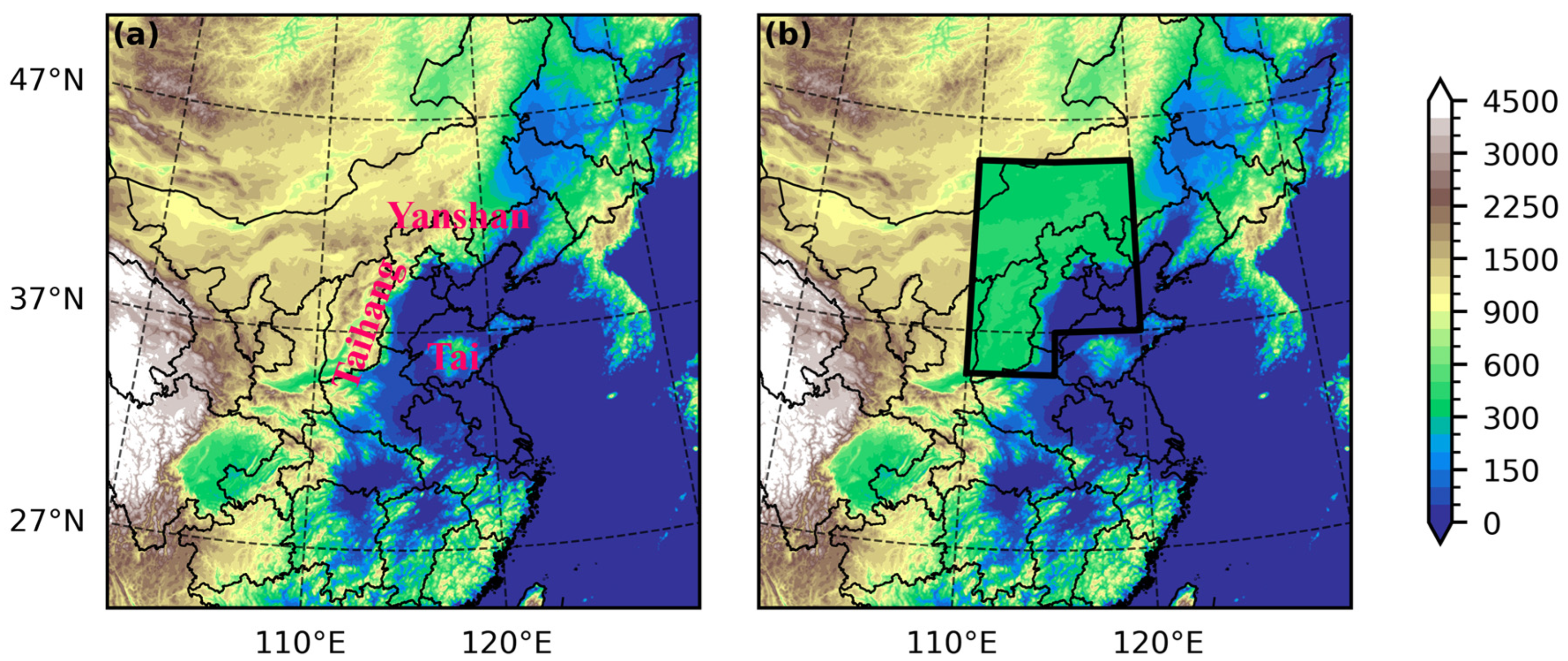
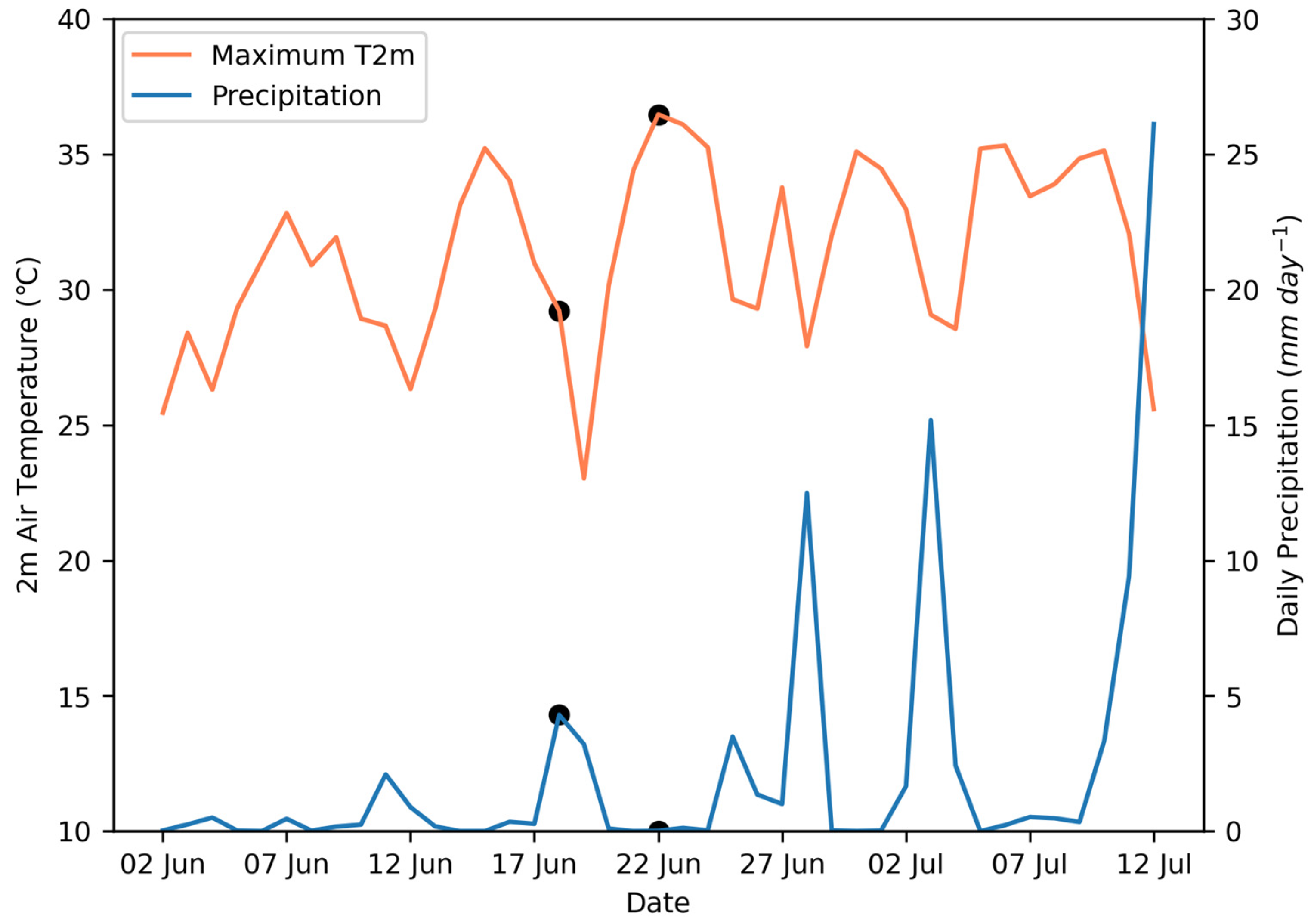
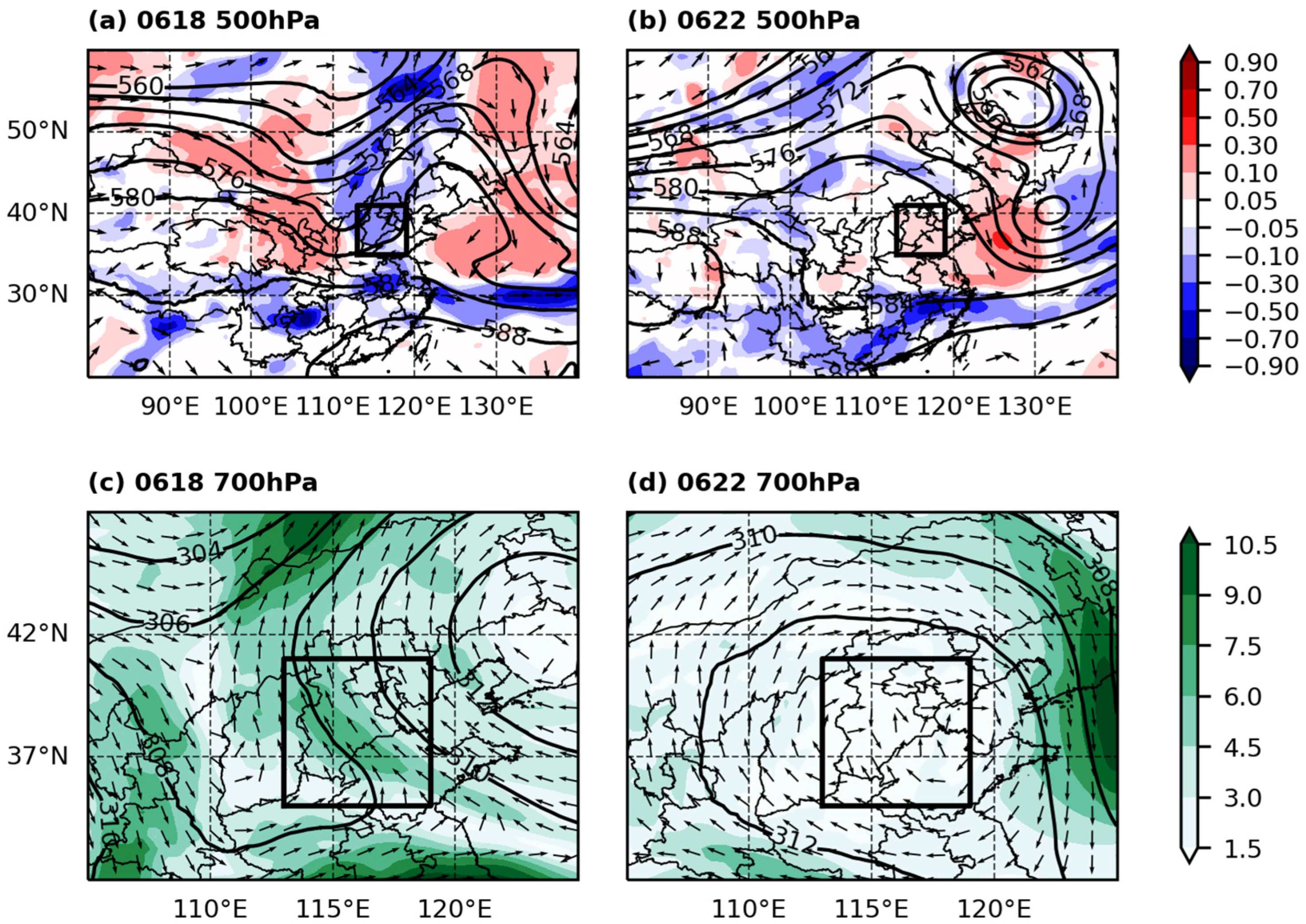
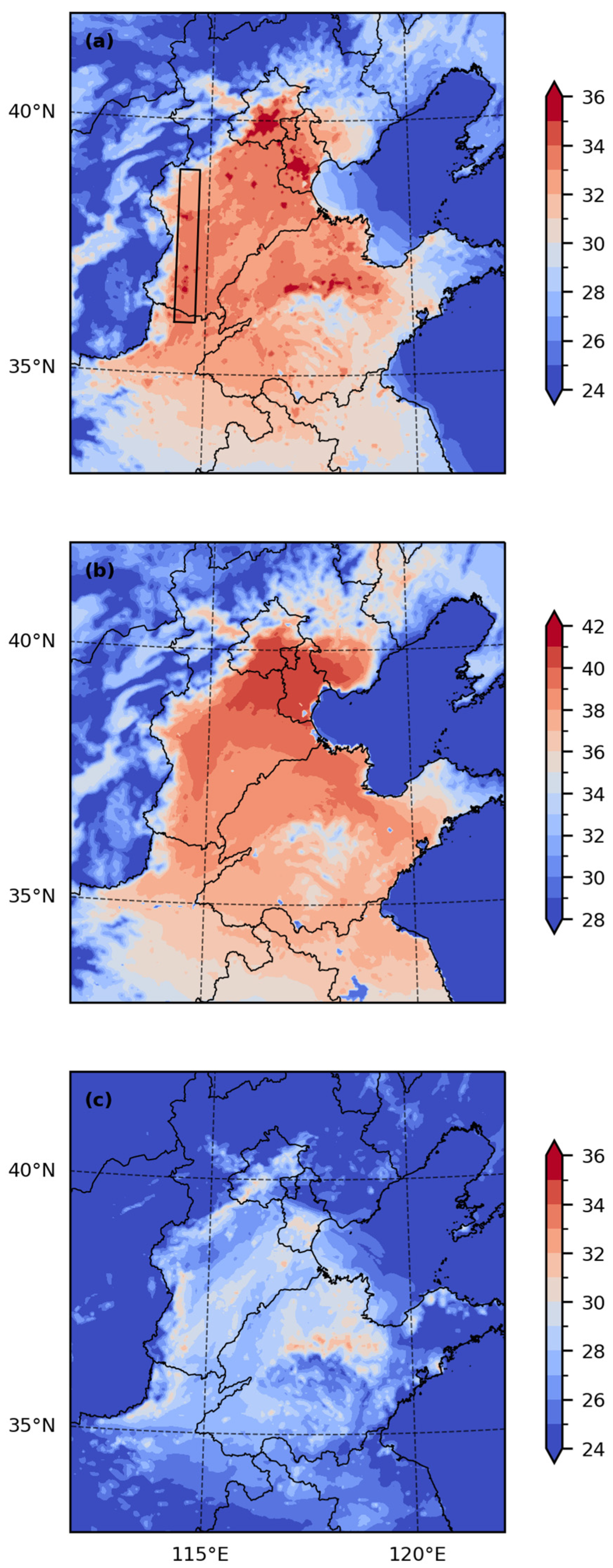
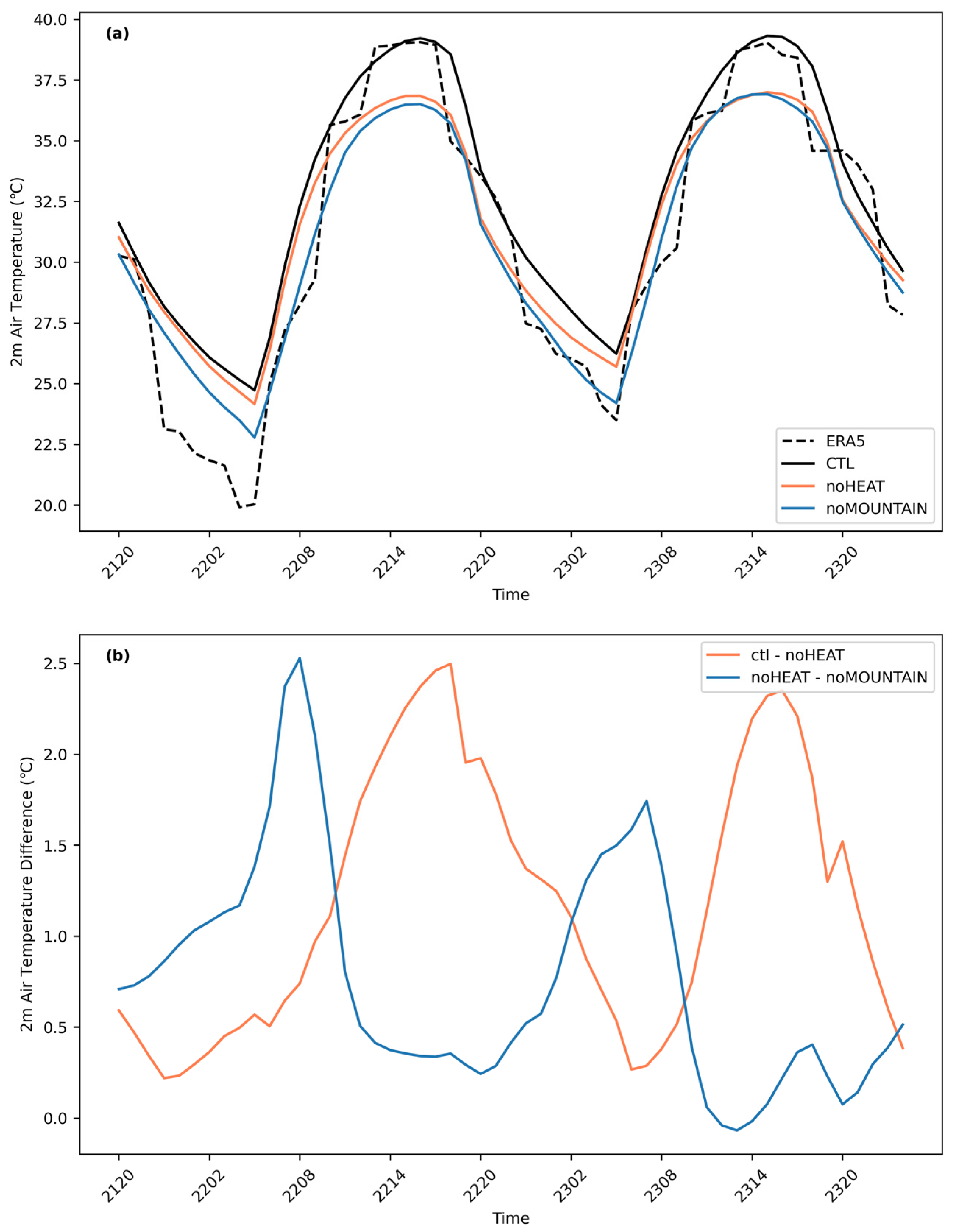
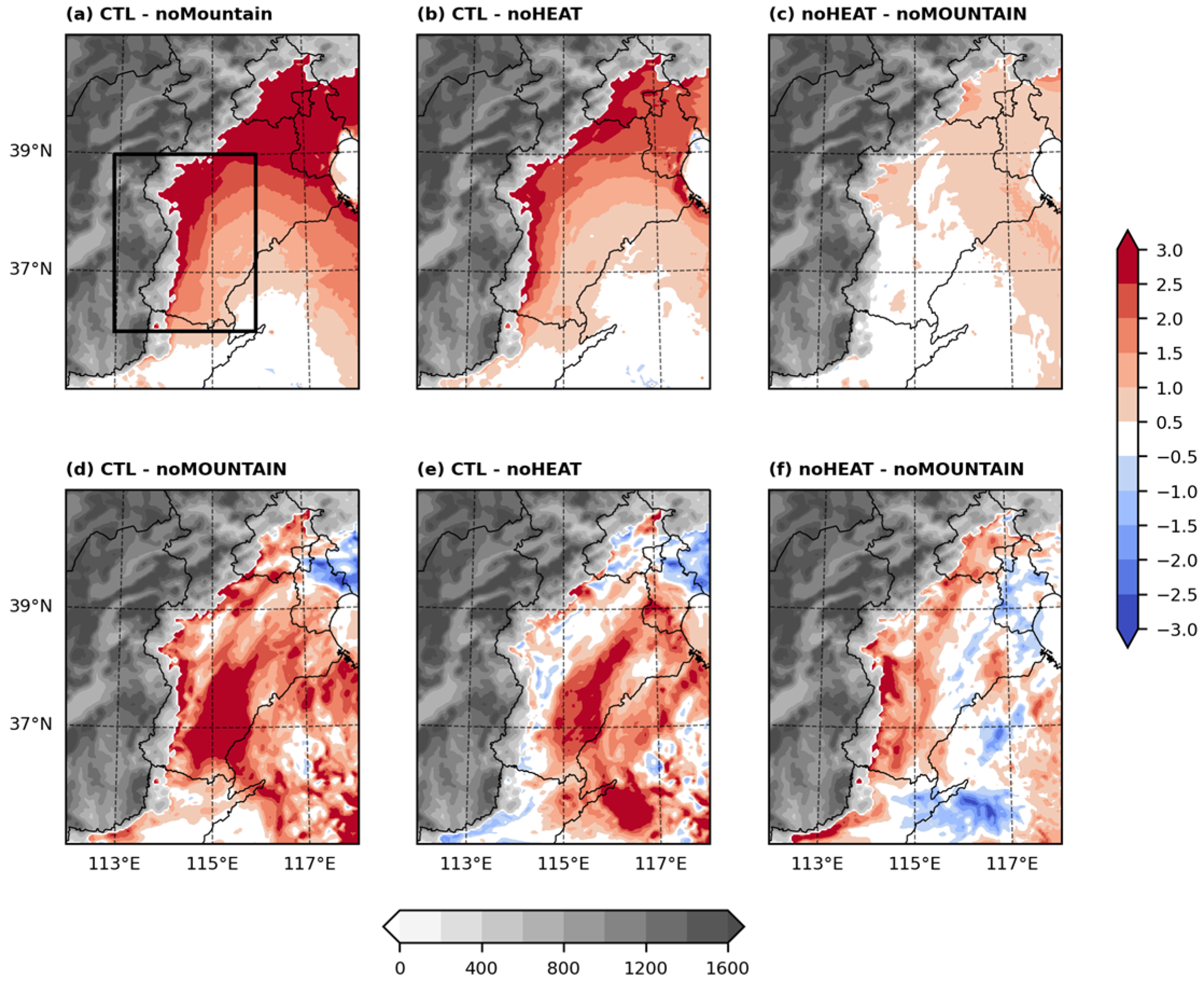

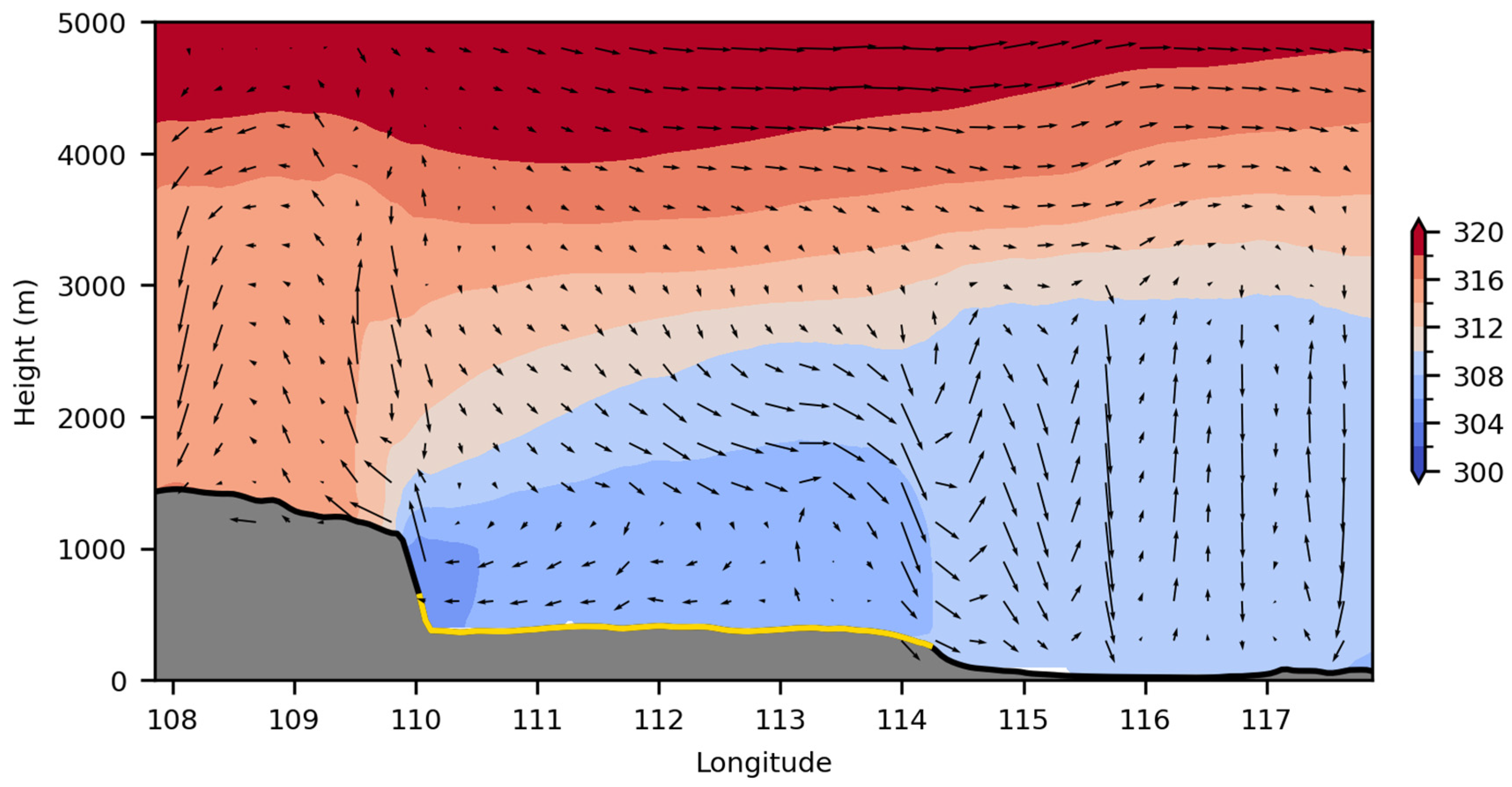
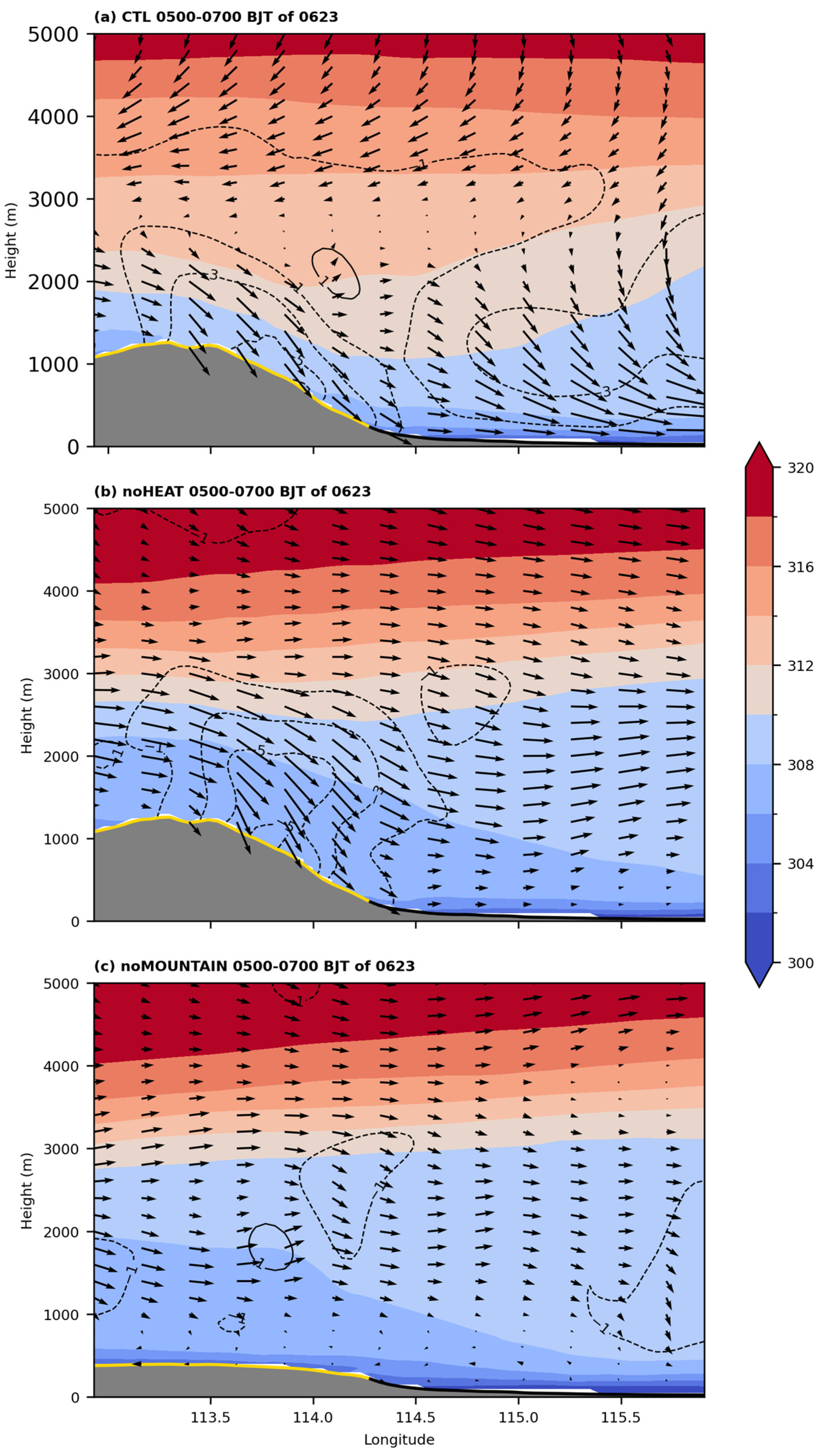



| Period (BJT) | CTL | noHEAT | noMOUNTAIN |
|---|---|---|---|
| Day (1300–1900) | 0.99 | 1.72 | 1.82 |
| Night (0100–0700) | 2.88 | 2.31 | 1.44 |
Disclaimer/Publisher’s Note: The statements, opinions and data contained in all publications are solely those of the individual author(s) and contributor(s) and not of MDPI and/or the editor(s). MDPI and/or the editor(s) disclaim responsibility for any injury to people or property resulting from any ideas, methods, instructions or products referred to in the content. |
© 2024 by the authors. Licensee MDPI, Basel, Switzerland. This article is an open access article distributed under the terms and conditions of the Creative Commons Attribution (CC BY) license (https://creativecommons.org/licenses/by/4.0/).
Share and Cite
Wu, H.; Xu, X.; Wang, Y. Effects of Orography on the High-Temperature Event on 22 June 2023 in North China. Atmosphere 2024, 15, 324. https://doi.org/10.3390/atmos15030324
Wu H, Xu X, Wang Y. Effects of Orography on the High-Temperature Event on 22 June 2023 in North China. Atmosphere. 2024; 15(3):324. https://doi.org/10.3390/atmos15030324
Chicago/Turabian StyleWu, Haoyang, Xin Xu, and Yuan Wang. 2024. "Effects of Orography on the High-Temperature Event on 22 June 2023 in North China" Atmosphere 15, no. 3: 324. https://doi.org/10.3390/atmos15030324
APA StyleWu, H., Xu, X., & Wang, Y. (2024). Effects of Orography on the High-Temperature Event on 22 June 2023 in North China. Atmosphere, 15(3), 324. https://doi.org/10.3390/atmos15030324







